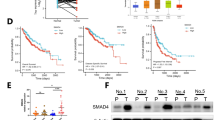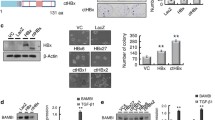Abstract
Hepatitis B virus (HBV) is implicated in the pathogenesis of hepatocellular carcinoma, which has been found to be associated with TGF-beta signaling. Activin A is a TGF-β family cytokine that exhibits cell proliferation inhibition on normal hepatocyte. How HBV-encoded X oncoprotein play in activin’s activity on hepatocyte has not been developed. In this study, a nontumor hepatic cell line HL7702 with HBX ectogenic expression has been established. MTT and BrdU assays showed that HBx promoted growth of HL7702 cells in vitro and downregulated activin signaling. Deregulated activin signaling pathway by HBX failed to activate target gene p21/waf1 and p15 transcription. In addition, mammalian two-hybrid and coimmunoprecipitation assays revealed that HBX could directly interact with activin signaling transduction protein Smad4, making activated Smad2/3/4 nucleus translocation suppressed. Furthermore, we detected that leptomycin B, the inhibitor of CRM1 protein, could recover nuclear translocation of endogenous Smads complex in HL7702 with HBX expression, indicating that HBX antagonized Smads nucleus translocation, at least partially, on CRM1-dependent manner. Leptomycin B was found to have antigrowth activity on HBX-expressed HL7702, according to its antitumor function in previous study. Above all, HBX antagonized activin signaling in normal human liver cells by interacting with Smad4 might one of the considerable causes of HBX-induced hepatocyte transformation, which deprived activin’s cell growth inhibition function at an early stage of tumorigenesis.





Similar content being viewed by others
References
Twu JS, Schloemer RH. Transcriptional trans-activating function of hepatitis B virus. J Virol. 1987;61(11):3448–53.
Wang WL, London WT, Lega L, Feitelson MA. HBxAg in the liver from carrier patients with chronic hepatitis and cirrhosis. Hepatology. 1991;14(1):29–37.
Yen TS. Hepadnaviral X protein: review of recent progress. J Biomed Sci. 1996;3(1):20–30.
Balsano C, Billet O, Bennoun M, Cavard C, Zider A, Grimber G, et al. Hepatitis B virus X gene product acts as a transactivator in vivo. J Hepatol. 1994;21(1):103–9.
Feitelson MA, Duan LX. Hepatitis B virus X antigen in the pathogenesis of chronic infections and the development of hepatocellular carcinoma. Am J Pathol. 1997;150(4):1141–57.
Lian Z, Liu J, Li L, Li X, Tufan NL, Clayton M, et al. Upregulated expression of a unique gene by hepatitis B x antigen promotes hepatocellular growth and tumorigenesis. Neoplasia. 2003;5(3):229–44.
Kew MC. Hepatitis B virus x protein in the pathogenesis of hepatitis B virus-induced hepatocellular carcinoma. J Gastroenterol Hepatol. 2011;26 Suppl 1:144–52.
Liu Y, Lou G, Wu W, Shi Y, Zheng M, Chen Z. Interferon-alpha sensitizes HBx-expressing hepatocarcinoma cells to chemotherapeutic drugs through inhibition of HBx-mediated NF-kappaB activation. Virol J. 2013;10:168.
Liu F, Li B, Nan Y. The effect of serum TGFβ1 of patients with chronic hepatitis B in liver fibrosis. Chin J Hepatol. 1999;7:196–8.
Chen W, Woodruff TK, Mayo KE. Activin A-induced HepG2 liver cell apoptosis: involvement of activin receptors and smad proteins. Endocrinology. 2000;141(3):1263–72.
Chen L, Zhang W, Liang HF, Zhou QF, Ding ZY, Yang HQ, et al. Activin A induces growth arrest through a SMAD-dependent pathway in hepatic progenitor cells. Cell Commun Signal CCS. 2014;12:18.
Wrana JL, Attisano L, Carcamo J, Zentella A, Doody J, Laiho M, et al. TGF beta signals through a heteromeric protein kinase receptor complex. Cell. 1992;71(6):1003–14.
Bianco C, Adkins HB, Wechselberger C, Seno M, Normanno N, De Luca A, et al. Cripto-1 activates nodal- and ALK4-dependent and -independent signaling pathways in mammary epithelial Cells. Mol Cell Biol. 2002;22(8):2586–97.
Harrison CA, Gray PC, Vale WW, Robertson DM. Antagonists of activin signaling: mechanisms and potential biological applications. Trends Endocrinol Metab TEM. 2005;16(2):73–8.
Gray PC, Shani G, Aung K, Kelber J, Vale W. Cripto binds transforming growth factor beta (TGF-beta) and inhibits TGF-beta signaling. Mol Cell Biol. 2006;26(24):9268–78.
Schulz R, Vogel T, Dressel R, Krieglstein K. TGF-beta superfamily members, ActivinA and TGF-beta1, induce apoptosis in oligodendrocytes by different pathways. Cell Tissue Res. 2008;334(3):327–38.
Shi Y, Bao YL, Wu Y, Yu CL, Huang YX, Sun Y, et al. Alantolactone inhibits cell proliferation by interrupting the interaction between Cripto-1 and activin receptor type II A in activin signaling pathway. J Biomol Screen. 2011;16(5):525–35.
Shangguan L, Ti X, Krause U, Hai B, Zhao Y, Yang Z, et al. Inhibition of TGF-beta/Smad signaling by BAMBI blocks differentiation of human mesenchymal stem cells to carcinoma-associated fibroblasts and abolishes their protumor effects. Stem Cells. 2012;30(12):2810–9.
Tan TL, Chen WN. A proteomics analysis of cellular proteins associated with HBV genotype-specific HBX: potential in identification of early diagnostic markers for HCC. J Clin Virol Off Publ Pan Am Soc Clin Virol. 2005;33(4):293–8.
Yu SJ, Kim YJ. Hepatitis B viral load affects prognosis of hepatocellular carcinoma. World J Gastroenterol WJG. 2014;20(34):12039–44.
Chen BF, Liu CJ, Jow GM, Chen PJ, Kao JH, Chen DS. High prevalence and mapping of pre-S deletion in hepatitis B virus carriers with progressive liver diseases. Gastroenterology. 2006;130(4):1153–68.
Benhenda S, Cougot D, Buendia MA, Neuveut C. Hepatitis B virus X protein molecular functions and its role in virus life cycle and pathogenesis. Adv Cancer Res. 2009;103:75–109.
Forgues M, Marrogi AJ, Spillare EA, Wu CG, Yang Q, Yoshida M, et al. Interaction of the hepatitis B virus X protein with the Crm1-dependent nuclear export pathway. J Biol Chem. 2001;276(25):22797–803.
Pierreux CE, Nicolas FJ, Hill CS. Transforming growth factor beta-independent shuttling of Smad4 between the cytoplasm and nucleus. Mol Cell Biol. 2000;20(23):9041–54.
Yen CJ, Lin YJ, Yen CS, Tsai HW, Tsai TF, Chang KY, et al. Hepatitis B virus X protein upregulates mTOR signaling through IKKbeta to increase cell proliferation and VEGF production in hepatocellular carcinoma. PLoS One. 2012;7(7):e41931.
Freudlsperger C, Bian Y, Contag Wise S, et al. TGF-β and NF-κB signal pathway cross-talk is mediated through TAK1 and SMAD7 in a subset of head and neck cancers. Oncogene. 2013;32(12):1549–59.
Lee DK, Park SH, Yi Y, Choi SG, Lee C, Parks WT, et al. The hepatitis B virus encoded oncoprotein pX amplifies TGF-beta family signaling through direct interaction with Smad4: potential mechanism of hepatitis B virus-induced liver fibrosis. Genes Dev. 2001;15(4):455–66.
Chung TW, Lee YC, Kim CH. Hepatitis B viral HBx induces matrix metalloproteinase-9 gene expression through activation of ERK and PI-3K/AKT pathways: involvement of invasive potential. FASEB J Off Publ Fed Am Soc Exp Biol. 2004;18(10):1123–5.
Jung JK, Kwun HJ, Lee JO, Arora P, Jang KL. Hepatitis B virus X protein differentially affects the ubiquitin-mediated proteasomal degradation of beta-catenin depending on the status of cellular p53. J Gen Virol. 2007;88(Pt 8):2144–54.
Gray PC, Harrison CA, Vale W. Cripto forms a complex with activin and type II activin receptors and can block activin signaling. Proc Natl Acad Sci U S A. 2003;100(9):5193–8.
Wrana JL, Attisano L. The Smad pathway. Cytokine Growth Factor Rev. 2000;11(1–2):5–13.
Ramachandran A, Marshall ES, Love DR, Baguley BC, Shelling AN. Activin is a potent growth suppressor of epithelial ovarian cancer cells. Cancer Lett. 2009;285(2):157–65.
Huss R, Theis S, Deeg HJ. CDK-inhibitor independent cell cycle progression in an experimental haematopoietic stem cell leukaemia despite unaltered Rb-phosphorylation. Br J Cancer. 1999;81(5):808–13.
Kim HY, Cho HK, Hong SP, Cheong J. Hepatitis B virus X protein stimulates the Hedgehog-Gli activation through protein stabilization and nuclear localization of Gli1 in liver cancer cells. Cancer Lett. 2011;309(2):176–84.
Kanamaru C, Yasuda H, Takeda M, et al. Smad7 Is Induced by Norepinephrine and Protects Rat Hepatocytes from Activin A-induced Growth Inhibition. J Biol Chem. 2001;276(49):45636–41.
Ji GZ, Wang XH, Miao L, et al. Role of transforming growth factor-beta1-smad signal transduction pathway in patients with hepatocellular carcinoma. World J Gastroenterol. 2006;12(4):644–8.
Park SG, Chung C, Kang H, Kim JY, Jung G. Up-regulation of cyclin D1 by HBx is mediated by NF-kappaB2/BCL3 complex through kappaB site of cyclin D1 promoter. J Biol Chem. 2006;281(42):31770–7.
Lim KH, Choi HS, Park YK, Park ES, Shin GC, Kim DH, et al. HBx-induced NF-kappaB signaling in liver cells is potentially mediated by the ternary complex of HBx with p22-FLIP and NEMO. PLoS One. 2013;8(3):e57331.
Patte C, Michon J, Frappaz D, Leverger G, Rubie H, Soussain C, et al. Therapy of Burkitt and other B-cell acute lymphoblastic leukaemia and lymphoma: experience with the LMB protocols of the SFOP (French Paediatric Oncology Society) in children and adults. Bailliere Clin Haematol. 1994;7(2):339–48.
Acknowledgements
This study was supported by grants from the National Natural Science Foundation of China (81301414) and the China Postdoctoral Science Foundation (2013M540245, 2014T70283) to Mingyu Lv, and The Fourth Youth Science Foundation of First Hospital of Jilin University (20121224) to Ying Shi.
Author information
Authors and Affiliations
Corresponding authors
Rights and permissions
About this article
Cite this article
Shi, Y., Zhang, H., Han, Z. et al. HBx interacted with Smad4 to deprive activin a growth inhibition function in hepatocyte HL7702 on CRM1 manner. Tumor Biol. 37, 3405–3415 (2016). https://doi.org/10.1007/s13277-015-4076-9
Received:
Accepted:
Published:
Issue Date:
DOI: https://doi.org/10.1007/s13277-015-4076-9




